
197 posts
. , --, 2392 . 20 , 600 , , , . , , , , , , , .





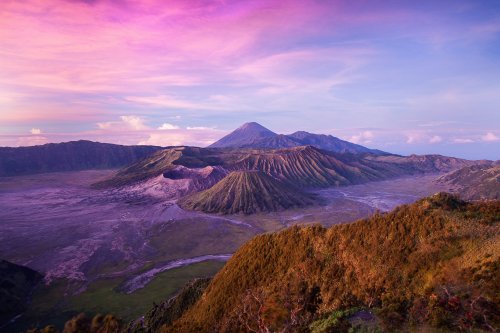

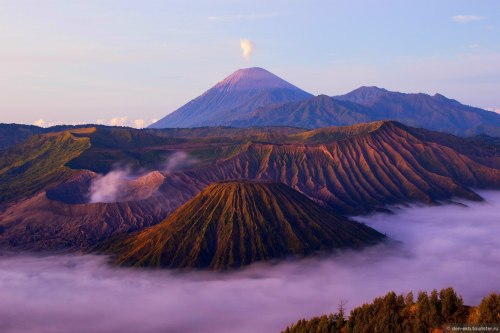










Вулкан Бромо на о. Ява, расположенный в национальном парке Бромо-Тенгер-Семеру, взмывает на высоту 2392 м и считается самым активным и «ненасытным» на острове. Последние 20 лет он постоянно «дышит», его огромный кратер диаметром 600 м все время наполнен дымом, а все вокруг, включая тропы и дороги вокруг вулкана, усыпаны густым слоем пепла. Однако это абсолютно не мешает Бромо привлекать многочисленных туристов, которые приезжают, чтобы полюбоваться фантастическими «лунными» пейзажами, посмотреть со смотровой площадки на могучий вулкан на рассвете, когда его склоны окрашиваются в розовые и золотые тона, и, наконец, совершить восхождение к кратеру и пройтись по его кромке на высоте птичьего полета.
Название Бромо происходит от яванского имени бога Брахмы, и находится вулкан посреди песчаной равнины, которую местные жители называют Сегара Веди, что значит «Песчаный океан». Здесь же, у северных склонов Бромо стоит индуистский храм Пура Лухур Потен, построенный из темных вулканических камней. Каждый год, начиная с XV в., тенгеры (яванская народность) целый месяц отмечают праздник Ядня Касада, во время которого они поднимаются к кратеру и сбрасывают в жерло вулкана жертвоприношения богам – фрукты, овощи, цветы, рис, кур и даже домашний скот, причем живьем. Именно поэтому Бромо и называют «ненасытным».
Лучшее время для посещения вулкана - с апреля по октябрь. Сезон дождей длится с декабря по март. Днем здесь прохладно, температура не превышает +20°C.
Mount Bromo on Java Island, located in the Bromo Tengger Semeru National Park, rises to a height of 2,392 m and is considered the most active and “insatiable” on the island. For the last 20 years, it has been constantly “breathing”, its huge crater with a diameter of 600 m is constantly filled with smoke, and everything around, including paths and roads around the volcano, is strewn with a thick layer of ash. However, this does not prevent Bromo from attracting numerous tourists who come to admire the fantastic “lunar” landscapes, look at the mighty volcano from the observation deck at dawn, when its slopes are painted in pink and gold tones, and, finally, climb to the crater and walk along its edge at a bird's eye view.
The name Bromo comes from the Javanese name of the god Brahma, and the volcano is located in the middle of a sandy plain, which the locals call Segara Wedi, which means “Sand Ocean”. Here, on the northern slopes of Bromo, there is a Hindu temple, Pura Luhur Poten, built of dark volcanic stones. Every year, since the 15th century, the Tenggerese (Javanese people) celebrate the Yadnya Kasada festival for a whole month, during which they climb to the crater and throw sacrifices to the gods into the volcano's mouth - fruits, vegetables, flowers, rice, chickens and even livestock. That is why Bromo is called "insatiable".
The best time to visit the volcano is from April to October. The rainy season lasts from December to March. It is cool here during the day, the temperature does not exceed +20°C.
Источник://t.me/krasivye_mesta_turizm,/vsegda-pomnim.com / vulkany/6053-vulkan-bromo-76-foto.html,//photopole.ru/krasivye-kartinki/vulkany-krasivye,/geosocks.com/bromo-volcano/, //thinking.ru/trips/indonesia/vulkan-bromo-na-indoneziyskom-ostrove-yava/,www.pac.ru/guide/indonesia/java/landmarks/mount-bromo/,/www.tripadvisor.ru/Attraction_Review-g297710-d2307699-Reviews-Bromo_Tengger_Semeru_Adventure-Malang_East _Java_ Java.html,//www.tourister.ru/world/asia/indonesia/city/malang/volcano/30191.
-
 gina025 liked this · 8 months ago
gina025 liked this · 8 months ago -
 dream-world-universe liked this · 9 months ago
dream-world-universe liked this · 9 months ago -
 vivelafranceblog liked this · 9 months ago
vivelafranceblog liked this · 9 months ago -
 asiablog-universe liked this · 9 months ago
asiablog-universe liked this · 9 months ago -
 sanoups liked this · 9 months ago
sanoups liked this · 9 months ago -
 instantlymaximumblaze reblogged this · 9 months ago
instantlymaximumblaze reblogged this · 9 months ago -
 01012180630 liked this · 9 months ago
01012180630 liked this · 9 months ago -
 blackpointgame liked this · 9 months ago
blackpointgame liked this · 9 months ago -
 voyagers-things liked this · 9 months ago
voyagers-things liked this · 9 months ago -
 instantlymaximumblaze liked this · 9 months ago
instantlymaximumblaze liked this · 9 months ago -
 1softerside liked this · 9 months ago
1softerside liked this · 9 months ago -
 omgindiablog liked this · 9 months ago
omgindiablog liked this · 9 months ago -
 aria-diary liked this · 9 months ago
aria-diary liked this · 9 months ago -
 rainbowderpturtle liked this · 9 months ago
rainbowderpturtle liked this · 9 months ago -
 angelayasmim liked this · 9 months ago
angelayasmim liked this · 9 months ago -
 zlukaszemprzezswiat liked this · 10 months ago
zlukaszemprzezswiat liked this · 10 months ago -
 1vidapoeticando liked this · 10 months ago
1vidapoeticando liked this · 10 months ago -
 mstoneuniverse liked this · 10 months ago
mstoneuniverse liked this · 10 months ago -
 milenamill liked this · 10 months ago
milenamill liked this · 10 months ago -
 senia-st liked this · 10 months ago
senia-st liked this · 10 months ago -
 synonymouswithanonymous liked this · 10 months ago
synonymouswithanonymous liked this · 10 months ago -
 gcswdc liked this · 10 months ago
gcswdc liked this · 10 months ago -
 gaiawatcher liked this · 10 months ago
gaiawatcher liked this · 10 months ago -
 zsoltisblog liked this · 10 months ago
zsoltisblog liked this · 10 months ago -
 mneel liked this · 10 months ago
mneel liked this · 10 months ago -
 vladimarinas-blog liked this · 10 months ago
vladimarinas-blog liked this · 10 months ago -
 biman1980 reblogged this · 10 months ago
biman1980 reblogged this · 10 months ago -
 biman1980 liked this · 10 months ago
biman1980 liked this · 10 months ago -
 theabsolonian liked this · 10 months ago
theabsolonian liked this · 10 months ago -
 el-zorro-chile liked this · 10 months ago
el-zorro-chile liked this · 10 months ago -
 islamprotestan-blog liked this · 10 months ago
islamprotestan-blog liked this · 10 months ago -
 adam-trademark liked this · 10 months ago
adam-trademark liked this · 10 months ago -
 analimas-blog liked this · 10 months ago
analimas-blog liked this · 10 months ago -
 suenosyfantasmas liked this · 10 months ago
suenosyfantasmas liked this · 10 months ago -
 thelostdreamsthings liked this · 10 months ago
thelostdreamsthings liked this · 10 months ago -
 djjdpeculiar81 liked this · 10 months ago
djjdpeculiar81 liked this · 10 months ago -
 olgagolovina liked this · 10 months ago
olgagolovina liked this · 10 months ago -
 thelcsdaily liked this · 10 months ago
thelcsdaily liked this · 10 months ago -
 rusilver liked this · 10 months ago
rusilver liked this · 10 months ago -
 rusilver reblogged this · 10 months ago
rusilver reblogged this · 10 months ago -
 kroner26 liked this · 10 months ago
kroner26 liked this · 10 months ago -
 madagio liked this · 10 months ago
madagio liked this · 10 months ago -
 mustafa-y-b liked this · 10 months ago
mustafa-y-b liked this · 10 months ago -
 manhaswife reblogged this · 10 months ago
manhaswife reblogged this · 10 months ago -
 manhaswife liked this · 10 months ago
manhaswife liked this · 10 months ago
More Posts from Vestaignis





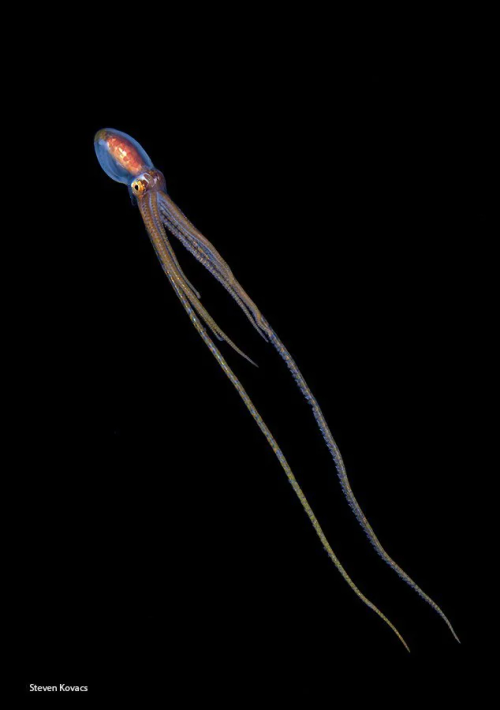







Macrotritopus defilippi, широко известный как длиннорукий осьминог-лилипут или атлантический длиннорукий осьминог, является небольшим видом осьминогов, морских головоногих моллюсков отряда Octopoda.
Macrotritopus defilippi - это небольшой осьминог с относительно длинными руками и мантией длиной до 90 мм (3,5 дюйма). Как и у большинства осьминогов, цвет кожи может варьироваться. Обычно он либо однотонный, либо в крапинку и полностью соответствует цвету окружающей местности, песчаных равнин, на которых он обитает. Там, где субстрат содержит гравий или песок, крапчатый рисунок часто крупнее, на коже могут быть небольшие сосочки (мясистые выпуклости), а на руках - светлые и темные полосы. Этот осьминог также может зарываться в субстрат, не оставляя никаких визуальных следов своего местонахождения.
Личинки Macrotritopus defilippi плавают с вытянутыми лапками и, если их потревожить, взлетают с помощью реактивного двигателя, иногда достигая морского дна и ища нору, в которой можно спрятаться. Ночью они могут вести пелагический образ жизни, а днем - бентический, но, по-видимому, с возрастом становятся менее ночными. Когда взрослая особь осьминога передвигается, то делает это таким образом, что его поведение при плавании очень напоминает поведение донных камбал, обитающих в тех же водах.
Macrotritopus defilippi был обнаружен в Атлантическом океане, включая Карибское море, Средиземное море, северную часть Индийского океана и побережье Сомали.
Macrotritopus defilippi, commonly known as the long-armed midget octopus or Atlantic long-armed octopus, is a small species of octopus, marine cephalopods of the order Octopoda.
Macrotritopus defilippi is a small octopus with relatively long arms and a mantle up to 90 mm (3.5 in) long. As with most octopuses, skin color can vary. It is usually either monophonic or speckled and fully corresponds to the color of the surrounding area, the sandy plains on which it lives. Where the substrate contains gravel or sand, the speckled pattern is often larger, there may be small papillae (fleshy bulges) on the skin, and light and dark stripes on the hands. This octopus can also burrow into the substrate without leaving any visual traces of its location.
Macrotritopus defilippi larvae swim with their legs outstretched and, if disturbed, take off using a jet engine, sometimes reaching the seabed and looking for a hole in which to hide. They can lead a pelagic lifestyle at night and a benthic lifestyle during the day, but apparently they become less nocturnal with age. When an adult octopus moves, it does so in such a way that its swimming behavior is very similar to that of bottom flounders living in the same waters.
Macrotritopus defilippi has been found in the Atlantic Ocean, including the Caribbean Sea, the Mediterranean Sea, the northern Indian Ocean and the coast of Somalia.
Источник://t.me/+E4YBiErj0A8wOGUy,//news.miami.edu/stories/2019/06/winners-announced-in-rosenstiel-school-underwater-photo-contest.html,//ru.pinterest.com/pin/632966922633183935/,/octonation.com/octopedia/atlantic-longarm-octopus/,//pofoto.club/17356-glubokovodnyj-osminog-57-foto.html, //en.wikipedia.org/ wiki/ Macrotritopus_defilippi.



















Замок «Соколиное гнездо».
Чешская Швейцария – это часть Эльбского Песчаникового горного массива, расположенная на территории Чехии. Здесь настолько невероятно красиво, что государство объявило в 2000 году это место национальным парком Чехии. Парк имеет много интересных мест, но самая интересная достопримечательность - это Правческая Брана или Правчицкие Ворота (Pravčická brána), которые представляют собой самые большие естественные ворота в Европе, образованные из скалистого массива - пролет арки 26,5 м, высота - 16 м.
В 1881 году австрийский принц Эдмунд Клари-Альдринген решил создать на территории своего имения в непосредственной близости от Правчицких ворот одну из самых первых туристических достопримечательностей Европы. Он нанял итальянских мастеров для строительства внушительного замка под названием «Соколиное гнездо». В нынешнее время в замке на втором этаже расположился музей Национального парка Чешская Швейцария, кстати, единственный. На первом этаже есть ресторан с сохранившейся до сих пор оригинальной отделкой деревянных стен и такими же оригинальными потолочными росписями. Интерьер заведения выдержанн в стиле 100-летней давности. С замковой площадки открываются чудесные виды на национальный парк.
The Falcon's Nest Castle.
Czech Switzerland is a part of the Elbe Sandstone Mountain range, located on the territory of the Czech Republic. It is so incredibly beautiful here that the state declared this place a national park of the Czech Republic in 2000. The park has many interesting places, but the most interesting attraction is The right Brane or Pravchicka Gate (Pravčická brána), which is the largest natural gate in Europe, formed from a rocky massif - arch span of 26.5 m, height - 16 m.
In 1881, Austrian Prince Edmund Clary-Aldringen decided to create one of the first tourist attractions in Europe on the territory of his estate in the immediate vicinity of the Pravchitsky Gate. He hired Italian craftsmen to build an impressive castle called the Falcon's Nest. At the present time, the museum of the Czech Switzerland National Park is located in the castle on the second floor, by the way, the only one. On the ground floor there is a restaurant with original wooden wall decoration and the same original ceiling paintings. The interior of the restaurant is designed in the style of 100 years ago. The castle grounds offer wonderful views of the national park.
Источник:/m-just-m.livejournal.com/246797.html, /www. tripadvisor . ru/LocationPhotoDirectLink-g274694-d4722298-i130392589-Czech_Saxon_Switzerland-Hrensko_Usti_ nad_Labem_ Region_ Bohemia.html,/pragagid.ru/letnij-zamok-sokolinoe-gnezdo-cheshskaya-shvejcariya-6157,/tired-tourist.livejournal.com/22927.html, /pbrana.cz/ru/,/gidpraga.eu/product/ceske-svycarsko-from-prague/.







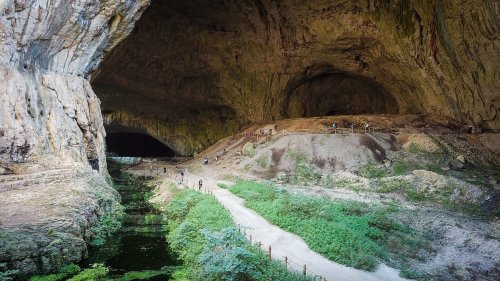















Пещера Деветашка считается одной из самых крупных в Болгарии и всей Европе. Она расположена на реке Осым, между селами Деветаки и Дойренци (Ловечская область). Пещера обнаружена лишь в 1921 году, а с 1996 года является охраняемым памятником природы. Ее протяженность составляет около 1,5 км, а входом служит гигантский проем 55 м в ширину и 35 м в высоту.
Пещера Деветашка поражает воображение туристов. Ее потолки высотой от 60 до 100 метров имеют многочисленные провалы, которые местные жители называют окнами. Они создают естественное освещение, но практически не нагревают пещеру. Поэтому здесь прохладно даже в знойные летние дни. Внутри протекает река, есть подземные озера, водопады, сталагмиты и сталактиты. В залах обитают летучие мыши, поэтому они закрыты с 1 ноября по 1 апреля, чтобы не мешать размножению животных.
В пещере обнаружены следы обитания древнего человека. Согласно археологическим исследованиям пещера служила убежищем людям с поздней палеолитической эпохи. Археологические раскопки обнаружили остатки из культурного слоя почти всех доисторических периодов. Рельефный слой толщиной от 0,3 до 5,5 м содержит остатки поселений разных эпох: палеолита(кремневые орудия мустьерских форм, позднепалеолитические изделия из кремня и костей); неолита (очаги с каменной основой, узкие каменные топоры, кремневые заточки и скребки, костяные лощила, шила и долота, керамику с резьбленными надписями); энеолита ( разрушенные жилища, печи, зернотерки,орудия из камня и костей, посуда с резной, рельефной и другой орнаментацией, антропоморфные фигуры); бронзового века (боевые топоры из бронзы, темнолощённые керамические изделия); железного века (бронзовые ножи, железное оружие).
Вторая мировая война оставила и здесь свой след. Во времена социализма пещера использовалась в качестве склада боеприпасов на случай военных действий, а также служила хранилищем нефтепродуктов. В пещере до сих пор остались следы в виде кругов с тех времен.
Немаловажной частью этого чудного места является разнообразие представителей фауны. В пещере обитают более сотни различных видов живности, некоторые из которых даже занесены в Красную книгу! В их числе 12 видов охраняемых земноводных (эскулап, полоз, тритон, древесные лягушки, черепахи Германа), около 80-ти видов птиц, 34 вида млекопитающих и 15 видов летучих мышей.
Devetashka Cave is considered one of the largest in Bulgaria and throughout Europe. It is located on the Osam River, between the villages of Devetaki and Doirentsi (Lovech region). The cave was discovered only in 1921, and since 1996 it has been a protected natural monument. Its length is about 1.5 km, and the entrance is a gigantic opening 55 m wide and 35 m high.
Devetashka Cave amazes tourists. Its ceilings range from 60 to 100 meters high and have numerous gaps, which locals call windows. They create natural light, but practically do not heat the cave. Therefore, it is cool here even on hot summer days. A river flows inside, there are underground lakes, waterfalls, stalagmites and stalactites. The halls are inhabited by bats, so they are closed from November 1 to April 1, so as not to interfere with the breeding of animals.
Traces of ancient human habitation were found in the cave. According to archaeological research, the cave has served as a shelter for people since the late Paleolithic era. Archaeological excavations have discovered remains from the cultural layer of almost all prehistoric periods. The relief layer, 0.3 to 5.5 m thick, contains the remains of settlements from different eras: Paleolithic (flint tools of Mousterian forms, Late Paleolithic objects made of flint and bones); Neolithic (hearths with a stone base, narrow stone axes, flint sharpenings and scrapers, bone polishes, awls and chisels, ceramics with carved inscriptions); Eneolithic (destroyed dwellings, ovens, grain grinders, tools made of stone and bones, dishes with carved, relief and other ornamentation, anthropomorphic figures); Bronze Age (battle axes made of bronze, dark-polished ceramics); Iron Age (bronze knives, iron weapons).
The Second World War left its mark here too. During socialism, the cave was used as an ammunition depot in case of hostilities, and also served as a storage facility for petroleum products. There are still traces in the cave in the form of circles from those times.
An important part of this wonderful place is the diversity of fauna. The cave is home to more than a hundred different species of living creatures, some of which are even listed in the Red Book! These include 12 species of protected amphibians (aesculapius, snake, newt, tree frogs, Hermann's tortoises), about 80 species of birds, 34 species of mammals and 15 species of bats.
Источник:/bulgariaexpert.ru/info/peschera-devetashka.php, /www. ntabulgaria.ru/blog/interesnye-mesta/peshhera-devetashka/, juicyworld.org/devetashka-cave/,/volimo-balkan.livejournal .com /450004.html,//meteo.by/around/c288c52491142c32.html, //www. tripadvisor.ru/Attraction_Review-g14037230-d4184576-Reviews-Devetashka_Cave-Devetaki_Lovech_Province.html,/bolgarskiydom .com/devetashka/.






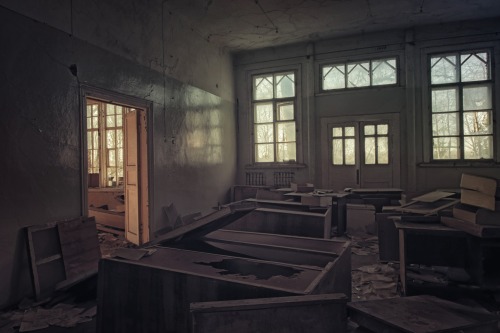












Заброшенная больница судорабочих в Рыбинске.
Ансамбль деревянных зданий расположен на левом берегу Волги на Бурлацкой улице, и скромно стоит в тени лип. С дороги хорошо виден главный корпус с надписью «Больница». Улица не случайно называется Бурлацкая, а на набережной Рыбинска стоит памятник бурлаку. Когда-то Рыбинск был негласной столицей бурлаков, профессии тяжелой и теперь давно забытой. Каждый год тысячи бурлаков стекались в город в дореволюционные годы.
Больница появилась в 1880 году. Первый вклад сделал купец А.Ф. Фролов, отдав под больницу свою землю, за ним и другие горожане пожертвовали деньги на строительство лечебницы. Вскоре были построены первые здания. Весь ансамбль больницы построен в неорусском стиле. Исполнение вызывает уважение мастерством обращения с деревом. Обшивка доской выполнена поперек, вдоль и ёлочкой, красив деревянный, резной на просвет фриз, изящная обналичка, детали выноса крыши, сохранилась мелкая расстекловка окон, филенчатые двери.Вообще, удивительно, что все эти деревянные постройки сохранились до сих пор и на территории больницы не было не одного пожара.
Врачи здесь принимали больных только во время навигации, лечение было бесплатным.Бурлаки и другой рабочий люд могли получить медицинскую помощь, постель, еду и приличное одеяние. Профиль больница сохранила и в советские времена. Сюда обращались речники и жители левого берега Волги. В 90-е жизнь в больнице начала угасать. Закрылся хирургический корпус, уехали врачи. Двери пустующих зданий заколотили, охранять ветшающие памятники культурного наследия оставили старенького сторожа.В 1993 году все здания больницы судорабочих были признаны выявленными памятниками культурного наследия.
Следить за сохранностью имущества сейчас некому, всё активно разрушается и приходит в упадок.Здания производят удручающее впечатление. Стекла в окнах разбиты, крыши сломаны, двери выбиты. В помещениях разбросаны документы. Памятник культуры, построенный рыбинцами, пережил падение империи и 70 лет советской власти. Теперь старой больнице самой нужна забота и лечение, иначе уникальный памятник исчезнет навсегда.
An abandoned hospital for ship workers in Rybinsk.
The ensemble of wooden buildings is located on the left bank of the Volga on Burlatskaya Street, and stands modestly in the shade of lime trees. The main building with the inscription "Hospital" is clearly visible from the road. It is no coincidence that the street is called Burlatskaya, and there is a monument to a boatman on the Rybinsk embankment. Once Rybinsk was the unspoken capital of boatmen, a difficult profession and now long forgotten. Every year thousands of boatmen flocked to the city in the pre-revolutionary years.
The hospital appeared in 1880. The first contribution was made by the merchant A.F. Frolov, who gave his land for the hospital, followed by other townspeople who donated money for the construction of the hospital. Soon the first buildings were built. The entire ensemble of the hospital is built in the neo-Russian style. The execution is respected by the skill of handling wood. The board covering is made across, along and with a herringbone pattern, a beautiful wooden frieze carved into the lumen, elegant cashing, details of the roof removal, small glazing of windows, paneled doors have been preserved.In general, it is surprising that all these wooden buildings have survived to this day and there has not been more than one fire on the territory of the hospital.
Doctors here took patients only during navigation, treatment was free.Boatmen and other working people could receive medical care, a bed, food and decent clothing. The hospital maintained its profile even in Soviet times. Rivermen and residents of the left bank of the Volga applied here. In the 90s, life in the hospital began to fade. The surgical building was closed, the doctors left. The doors of empty buildings were boarded up, and an old watchman was left to guard the dilapidated monuments of cultural heritage.In 1993, all the buildings of the Shipbuilders Hospital were recognized as identified cultural heritage monuments.
There is no one to monitor the safety of property now, everything is actively being destroyed and falling into disrepair.The buildings make a depressing impression. The glass in the windows is broken, the roofs are broken, the doors are knocked out. Documents are scattered in the rooms. The cultural monument built by the Rybintsy survived the fall of the empire and 70 years of Soviet rule. Now the old hospital itself needs care and treatment, otherwise the unique monument will disappear forever.
Источник:://rblogger.ru/2015/12/05/bolnitsa-v-ryibinske/,/vk.com/ wall-24572207_3398,//dzen.ru/a/ YL4FQxs_XCImk2Gs ,/dzen.ru /a/ X8ovW3iO2nXHM3rn.
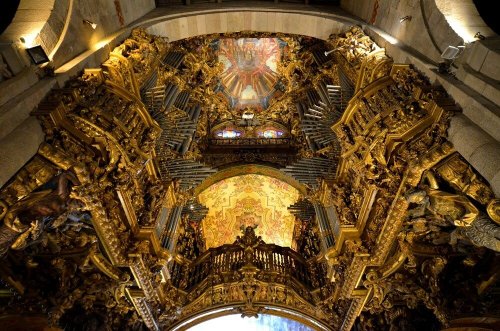



























Кафедральный собор Браги (собор пресвятой Девы Марии) — одна из главных достопримечательностей Португалии. Строительство собора было приурочено к освобождению христианами Браги от мавров, захвативших город почти на 355 лет. Первый епископ после восстановления епископской кафедры в 1071 году – Педру – начал строительство храма. Свой окончательный вид собор приобрел только к концу XII века, а полностью достроен был в середине XIII.
Во внешнем виде собора присутствует смешение разнообразных архитектурных стилей. Если первоначально здание собора было построено в романском стиле с бургундским влиянием, то капеллы, позже пристроенные, и предхрамие – это уже готика. Главная аспидная часть исполнена в стиле мануэлино. Церковный фасад украшают две высокие колокольни, а по центру между гербами Португалии и Диего де Сауса возвышается Божья Матерь, кормящая младенца. Архитектурный ансамбль богато украшен орнаментами, фризами, скульптурными композициями, изображающими святых, животных и химер.
Внутреннее убранство поражает роскошью. Главный алтарь архитектора Жуана де Кастилью изыскано, украшено золотом. Над центральным нефом расположены два старинных органа. Барочный ансамбль щедро оснащен резным орнаментом. Собор имеет пять капелл, каждая из которых заслуживает внимания. Особо выделяется усыпальница архиепископа Гонсалу Перейры, резной каменный саркофаг (1331 год) архитектора Телу Гарсия и надгробная статуя, работа Перу. Эти элементы считаются шедевром средневековой португальской архитектуры. Гробница находится под охраной шести каменных львов.
В остальных капеллах захоронены значимые политические деятели и почитаемые личности – Генрих Бургундский, Тереза Леонская, Афонсу Португальский и другие. Еще с XVII века в музее собора формируется коллекция колоколов. Уже собрано более 200 экземпляров. Тут же представлены ювелирные изделия, живопись и скульптуры религиозной тематики. Кафедральный собор Браги находится в историческом центре города и буквально окружен архитектурными шедеврами. В радиусе 200 метров от собора находится Церковь Милосердия, Епископский Дворец, Церковь Сан-Жуан-ду-Суто, Капелла Куимбраш.
The Cathedral of Braga (Cathedral of the Blessed Virgin Mary) is one of the main attractions of Portugal. The construction of the cathedral was timed to coincide with the liberation of Braga by Christians from the Moors, who captured the city for almost 355 years. The first bishop after the restoration of the episcopal see in 1071, Pedro– began the construction of the temple. The cathedral acquired its final appearance only by the end of the XII century, and was completely completed in the middle of the XIII century.
In the exterior of the cathedral there is a mixture of various architectural styles. If the original building of the cathedral was built in the Romanesque style with a Burgundian influence, then the chapels, later added, and the pre–temple are already Gothic. The main viper part is executed in the Manueline style. The church facade is decorated with two tall bell towers, and in the center between the coats of arms of Portugal and Diego de Sausa stands the Mother of God nursing a baby. The architectural ensemble is richly decorated with ornaments, friezes, sculptural compositions depicting saints, animals and chimeras. The interior is striking in luxury. The main altar of the architect Juan de Castilla is exquisitely decorated with gold. Two ancient organs are located above the central nave. The Baroque ensemble is generously equipped with carved ornaments. The cathedral has five chapels, each of which deserves attention. The tomb of Archbishop Gonzalo Pereira, the carved stone sarcophagus (1331) by architect Telo Garcia and the tombstone statue, the work of Peru, stand out in particular. These elements are considered a masterpiece of medieval Portuguese architecture. The tomb is guarded by six stone lions.
In the other chapels, significant political figures and revered personalities are buried – Henry of Burgundy, Teresa of Leon, Afonso of Portugal and others. Since the XVII century, a collection of bells has been formed in the cathedral museum. More than 200 copies have already been collected. Jewelry, paintings and sculptures of religious themes are also presented here. The Cathedral of Braga is located in the historical center of the city and is literally surrounded by architectural masterpieces. Within a radius of 200 meters from the cathedral there is the Church of Mercy, the Episcopal Palace, the Church of San Juan do Suto, the Chapel of Cuimbrache.
Источник://telega.in/c/krasivye_mesta_turizm,/uritsk.livejournal.com/198306.html,/fotobrodilki.ru/braga-portugal/, /disk.yandex.ru/ a/ 5gXImKWa3VkYAG,/www.tourister.ru/world/europe/portugal/city/braga/temples/15876/responses/7805,://rutraveller.ru/place/97732/photos?fs=1820878, /www.turizm.ru/portugal/braga/places/ kafedralnyj _ sobor_bragi/,Attraction_Review-g189171-d318707-Reviews-Se_de_Braga-Braga_Braga_District_Northern_Portugal.html.